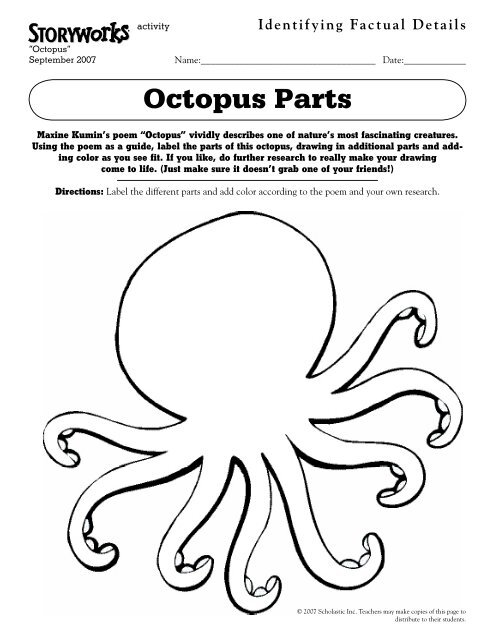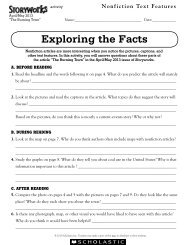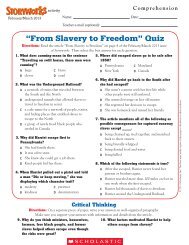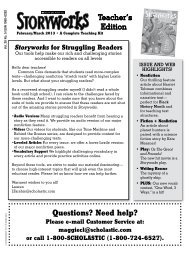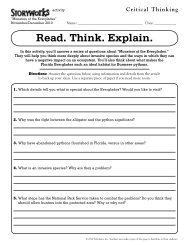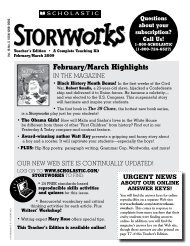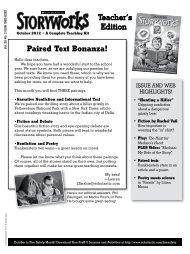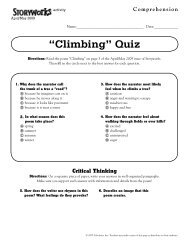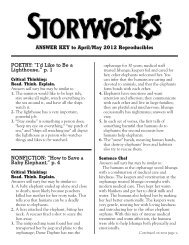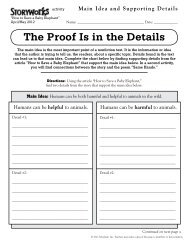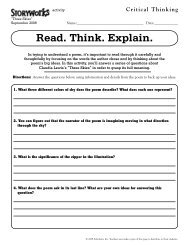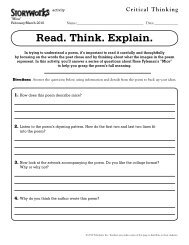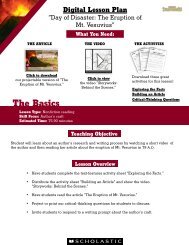Octopus Parts - Storyworks - Scholastic
Octopus Parts - Storyworks - Scholastic
Octopus Parts - Storyworks - Scholastic
You also want an ePaper? Increase the reach of your titles
YUMPU automatically turns print PDFs into web optimized ePapers that Google loves.
“<strong>Octopus</strong>”<br />
September 2007<br />
activity<br />
Identifying Factual Details<br />
Name:____________________________________ Date:_____________<br />
<strong>Octopus</strong> <strong>Parts</strong><br />
Maxine Kumin’s poem “<strong>Octopus</strong>” vividly describes one of nature’s most fascinating creatures.<br />
Using the poem as a guide, label the parts of this octopus, drawing in additional parts and adding<br />
color as you see fit. If you like, do further research to really make your drawing<br />
come to life. (Just make sure it doesn’t grab one of your friends!)<br />
Directions: Label the different parts and add color according to the poem and your own research.<br />
© 2007 <strong>Scholastic</strong> Inc. Teachers may make copies of this page to<br />
distribute to their students.
“<strong>Octopus</strong>”<br />
September 2007<br />
activity<br />
Poetry Writing/Research<br />
Name:____________________________________ Date:_____________<br />
The Poem Zoo<br />
Some poems aren’t just beautiful to read, they are filled with facts. In this activity, you will<br />
research an animal that inspires you and then write a poem based on what you’ve learned.<br />
Directions: Think of an animal to research (check out www.bbc.co.uk/nature/reallywild).<br />
In section one, fill in the facts about your animal, and add interesting ideas of your own.<br />
In section two, think of adjectives and beautifully descriptive phrases for each fact you found.<br />
Finally, write a poem about your animal inspired by “<strong>Octopus</strong>,” by Maxim Kumin.<br />
1. What my animal looks like<br />
2. Where my animal lives<br />
3. What my animal eats<br />
4. How my animal moves<br />
5. Something unique about my animal<br />
1.<br />
2.<br />
3.<br />
4.<br />
5.<br />
Section 1: Facts about your favorite animal<br />
Section 2: Poetic words and phrases that describe your animal<br />
Section 3: On a separate piece of paper, write a poem about your animal.<br />
© 2007 <strong>Scholastic</strong> Inc. Teachers may make copies of this page to distribute to their students.
“A Circle of Sun”<br />
September 2007<br />
activity<br />
Exploring Metaphors<br />
Name:____________________________________ Date:_____________<br />
A Poem Is a Ray of Sunshine.<br />
The sentence above is a metaphor—a statement in which an author describes something by calling<br />
it something else. You’re probably using metaphors without knowing it—like when your little brother<br />
throws his dirty sock at you, and you say, “You’re a monster!” You don’t mean that he has green skin<br />
and claws. You are comparing him to something monstrous to make your point.<br />
This activity will help you become a metaphor pro.<br />
1. My family is my rock.<br />
2. This ice cream is<br />
3. School is<br />
4. I am<br />
Directions: For each item listed below, think of a metaphor<br />
that will help you describe it in a new and interesting way.<br />
Now, explain how each metaphor works.<br />
What does the comparison tell you about the original object?<br />
1. You love your family and know they are always there for you.<br />
They are solid and never budge, like a rock.<br />
2.<br />
3.<br />
4.<br />
Write Now!<br />
Pick your favorite metaphor from your list above and write a short poem about it, using “A Circle of Sun” as a<br />
model. Use a separate piece of paper.<br />
© 2007 <strong>Scholastic</strong> Inc. Teachers may make copies of this page to distribute to their students.
“A Circle of Sun”<br />
September 2007<br />
activity<br />
Poetry Writing/Word Study<br />
Name:______________________________ Date:_____________<br />
A Burst of Vocabulary<br />
Giggle, grin, gallop. Rebecca Kai Dotlich’s exuberant poem soars because of the fun<br />
and interesting words she uses. You will recognize them, but you might not use energetic words<br />
like them very often. In this activity, you will find fun synonyms for words in the poem.<br />
Directions: For each of the words in the sunburst below, write down three synonyms, or words<br />
that mean the same thing, on the sun’s rays. Then, choose another favorite word from the poem and<br />
find three synonyms to write inside the sun. Try this on your own, but if you get stumped, you can use a thesaurus.<br />
D A N C I N G<br />
G R I N<br />
S I N G I N G<br />
G A L L O P<br />
S H O U T<br />
© 2007 <strong>Scholastic</strong> Inc. Teachers may make copies of this page to distribute to their students.
“The Man-Eaters of Tsavo”<br />
September 2007<br />
activity<br />
Identifying Character Motivations<br />
Name:____________________________________ Date:_____________<br />
Now Why’d He Do That?<br />
Colonel Patterson wasn’t planning to hunt man-eating lions when he went to Africa. But after the<br />
dangerous beasts appeared, he had to make some scary decisions. Why did he make the choices<br />
he did? Understanding why a character, or real-life figure, thinks or acts the way he does can<br />
help you understand the story better. In this activity, you will consider some of Colonel Patterson’s<br />
thoughts and actions and find explanations, or “motivations,” for each one in the article.<br />
Directions: In the left-hand column, write down Colonel Patterson’s thoughts or actions<br />
(we did the first one for you!). In the right-hand column, write down what caused each thought or action.<br />
1. Colonel Patterson traveled to Kenya.<br />
2.<br />
3.<br />
4.<br />
WHAT COLONEL PATTERSON DID WHY HE DID IT<br />
1.<br />
2.<br />
3.<br />
4.<br />
© 2007 <strong>Scholastic</strong> Inc. Teachers may make copies of this page to distribute to their students.
“The Man-Eaters of Tsavo”<br />
September 2007<br />
activity<br />
Fact/Opinion<br />
Name:____________________________________ Date:_____________<br />
Fact or Opinion?<br />
The Uganda Railroad stretched 500 miles. The jungle it cut through was too scary and dangerous.<br />
One of those sentences is a fact, something that can be proved. The other is an opinion,<br />
an expression of an individual’s thoughts or beliefs. But how do you tell the difference?<br />
Ask youself, which one can you measure, test, or otherwise prove? That’s the fact.<br />
And which one might sound different depending who says it? That one is an opinion.<br />
1. The Tsavo Forest is in<br />
present-day Kenya.<br />
Directions: Circle F for fact or O for opinion on the railroad tie by each statement below.<br />
2. The lions lacked their natural<br />
prey due to drought and<br />
disease.<br />
3. No one would want to work in<br />
the snake-infested jungle where<br />
the railroad workers cut a path.<br />
4. Over nine months, two lions<br />
killed 135 men.<br />
5. Colonel Patterson did the right<br />
thing by shooting the lions.<br />
F O F O<br />
F O F O<br />
F O F O<br />
F O F O<br />
F O F O<br />
6. Mombasa was a beautiful,<br />
dazzling city.<br />
7. Inghan Singh’s tentmates<br />
witnessed the lions attack<br />
on him.<br />
8. The lions acted like devils.<br />
9. The lions are now on display<br />
at the Field Museum in<br />
Chicago.<br />
10. Humans suffered more than<br />
lions in the events of 1898.<br />
© 2007 <strong>Scholastic</strong> Inc. Teachers may make copies of this page to distribute to their students.
“The Man-Eaters of Tsavo”<br />
September 2007<br />
activity<br />
Summarizing<br />
Name:____________________________________ Date:_____________<br />
Important Events<br />
The hardest part of writing a summary of an article is pinpointing the really important<br />
information—the facts that are key to understanding the main point of the story. The truth<br />
is that sometimes the most fun and interesting pieces of information are not always needed<br />
to understand the larger picture. In this activity, you will think about the important events<br />
in “The Man-Eaters of Tsavo” and figure out which events belong in your summary.<br />
Directions: In the space below, summarize “The Man-Eaters of Tsavo.”<br />
Make sure you recognize the difference between the big events and the surrounding details.<br />
1. Write a list of the important events in “The Man-Eaters of Tsavo.” Use one sentence for each main action.<br />
2. Look over your list and make sure that every action you have written is important. Cross off any event<br />
that is not needed to tell the story, even if it seems really interesting to you.<br />
3. Using your notes from above, write a short summary of “The Man-Eaters of Tsavo” on a separate piece<br />
of paper. Remember to make sure that each event you choose to include is important.<br />
© 2007 <strong>Scholastic</strong> Inc. Teachers may make copies of this page to distribute to their students.
“The Stars Below Me”<br />
September 2007<br />
activity<br />
Understanding Character<br />
Name:______________________________ Date:_____________<br />
I Can Prove It!<br />
Part of what makes “The Stars Below Me” such an interesting and engaging story<br />
is its main character, Mara. In this activity, you’ll think of adjectives that describe Mara<br />
and then, for each adjective, find details that demonstrate why you would describe her that way.<br />
Directions: In each bubble, write a word or a phrase to describe her character. Then, below each bubble,<br />
list examples from the story that show Mara exhibiting this trait. We’ve gotten you started!<br />
Imaginative<br />
Mara<br />
• Misses the wide-open spaces<br />
in the country.<br />
• Refuses to drink her mom’s<br />
hot chocolate the first night.<br />
• Complains about not being<br />
able to see the stars.<br />
Write Now!<br />
Now, take out a separate piece of paper. Using one of the bubbles you completed above, write a short paragraph<br />
describing Mara. Remember to include supporting details to make her character come alive!<br />
© 2007 <strong>Scholastic</strong> Inc. Teachers may make copies of this page to distribute to their students.
“The Stars Below Me”<br />
September 2007<br />
activity<br />
Comparing/Contrasting Settings<br />
Name:____________________________________ Date:_____________<br />
Time and Place<br />
What is the setting of a story? It’s where and when the story takes place:<br />
a town or a city; last month or 500 years ago; in America or in a land of fantasy.<br />
This activity will help you learn to pay close attention to the setting of the stories and novels<br />
you read, and to appreciate how a setting can affect practically everything in a story.<br />
1. Where does this story take place?<br />
2. Is it a big city or a small town?<br />
Directions: Answer the questions below.<br />
Where? When?<br />
3. How do you know? (Give examples from<br />
the story.)<br />
4. When does the story take place?<br />
5. How do you know this?<br />
6. What language does the author,<br />
Wendy Mass, use to convey this fact?<br />
Write Now!<br />
Could this story have happened 100 years ago? What details would have had to change?<br />
Write a well-organized paragraph explaining your answer, using details from the story and your own ideas.<br />
© 2007 <strong>Scholastic</strong> Inc. Teachers may make copies of this page to distribute to their students.
“The Stars Below Me”<br />
September 2007<br />
activity<br />
Text-to-Self<br />
Name:____________________________________ Date:_____________<br />
The Stars Above You<br />
Part of the fun of reading fiction is thinking to yourself, “Why do I find the objects in the story<br />
interesting? How do they make me feel?” In this activity, you will compare your thoughts and<br />
feelings about stars with how they were portrayed in the story “The Stars Below Me.”<br />
Directions: Write down a list of words or phrases to answer the question in each star below.<br />
What do stars<br />
look like?<br />
How does<br />
stargazing make you feel?<br />
STARS<br />
What do stars do?<br />
(hint: twinkle, shine)<br />
How did reading about Eta and<br />
Mara’s friendship make you feel?<br />
Write Now!<br />
Do you like stargazing as much as Mara does? On a separate piece of paper, write a paragraph answering<br />
this question and base it on what you wrote above. Use examples from your life and from the story.<br />
© 2007 <strong>Scholastic</strong> Inc. Teachers may make copies of this page to distribute to their students.
“Yesterday & Today”<br />
September 2007<br />
1.<br />
2.<br />
3.<br />
4.<br />
5.<br />
activity<br />
Compare/Contrast<br />
Name:____________________________________ Date:_____________<br />
Five and Five<br />
In this activity, you will compare and contrast Frank Duryea<br />
and Kasey Kahne from this month’s “Yesterday & Today” feature.<br />
Directions: In the box on the left, write five facts about Frank Duryea from<br />
the “Yesterday & Today” article. In the box on the right, write five facts about Kasey Kahne.<br />
Facts<br />
Frank Duryea Kasey Kahne<br />
Write Now!<br />
Use your list to write a well-organized paragraph in which you compare and contrast<br />
race-car drivers Frank Duryea and Kasey Kahne. (Use a separate piece of paper.)<br />
1.<br />
2.<br />
3.<br />
4.<br />
5.<br />
© 2007 <strong>Scholastic</strong> Inc. Teachers may make copies of this page to distribute to their students.
The Dark is Rising<br />
September 2007<br />
activity<br />
Main Idea/Supporting Details<br />
Name:____________________________________ Date:_____________<br />
Big Ideas<br />
A main idea is what a story is really about—the fight between good and evil, for example,<br />
or a character who wants to grow and change in some way. Usually there are two or three main<br />
ideas in a story, and there are always details that give you clues about what the main ideas are.<br />
In this activity, you will figure out the main ideas of the play The Dark is Rising<br />
and find the “supporting” details for each one.<br />
Directions: Read each main idea below. Then, in the boxes below them, list three details from the play<br />
that support each idea. You will need to keep the play handy and refer to it throughout the activity.<br />
Be specific! We got you started.<br />
MAIN IDEA<br />
The Light and the Dark are locked in an ongoing struggle.<br />
SUPPORTING DETAIL 1<br />
Merriman and Miss Greythorne tell Will that “the dark is rising.”<br />
SUPPORTING DETAIL 2<br />
SUPPORTING DETAIL 3<br />
Continued8<br />
© 2007 <strong>Scholastic</strong> Inc. Teachers may make copies of this page to distribute to their students.
activity<br />
Main Idea/Supporting Details<br />
Page 2<br />
MAIN IDEA<br />
The Rider wants to stop Will.<br />
SUPPORTING DETAIL 1<br />
SUPPORTING DETAIL 2<br />
SUPPORTING DETAIL 3<br />
Continued8<br />
© 2007 <strong>Scholastic</strong> Inc. Teachers may make copies of this page to distribute to their students.
activity<br />
Main Idea/Supporting Details<br />
Page 3<br />
MAIN IDEA<br />
Will has a lot to learn about the strange events happening around him.<br />
SUPPORTING DETAIL 1<br />
SUPPORTING DETAIL 2<br />
SUPPORTING DETAIL 3<br />
© 2007 <strong>Scholastic</strong> Inc. Teachers may make copies of this page to distribute to their students.
The Dark is Rising<br />
September 2007<br />
activity<br />
Making Predictions<br />
Name:____________________________________ Date:_____________<br />
A Sign of What’s to Come<br />
A church filled with snakes! What will happen next? At the end of a suspenseful play like<br />
The Dark is Rising, and throughout any story or book, you should continue to ask that question.<br />
Making a prediction, or imagining the answer to “what happens next?” is an important part<br />
of being a good reader. You can find clues in the story, the pictures, the captions, everywhere!<br />
Directions: Follow the prompts in each box to write your predictions about The Dark is Rising.<br />
Will The Walker steal from Will? Why did you think that? (What were your clues?)<br />
What will happen to Will, Merriman and Miss<br />
Greythorne inside the snake-filled church?<br />
Why did you think that? (What were your clues?)<br />
Do you think Will will ever give the Sign to the Rider? Why did you think that? (What were your clues?)<br />
Will the Old Ones prevent the Dark from rising? Why did you think that? (What were your clues?)<br />
Write Now!<br />
Why is it important to make predictions when you’re reading a story or a book?<br />
How does this help you become a better reader? Write your answer in a well-organized paragraph.<br />
© 2007 <strong>Scholastic</strong> Inc. Teachers may make copies of this page to distribute to their students.
The Dark is Rising<br />
September 2007<br />
activity<br />
Genre Study<br />
Name:______________________________ Date:_____________<br />
The Elements of Fantasy<br />
The Dark is Rising is a work of fantasy. But what does that mean? Fantasy is a genre, the word<br />
for a category of books with similar features, stories, or characters. While books and movies in the<br />
fantasy genre have lots of differences, some elements often reappear and help us to identify<br />
the type of story we’re following. In this activity, you will find examples of four elements<br />
of the fantasy genre from the play version of The Dark is Rising.<br />
Directions: Read The Dark is Rising and fill in the boxes with examples<br />
from the play of each of the elements of fantasy listed below.<br />
1. Characters have special powers.<br />
2. Objects have special powers.<br />
3. There is a fight between<br />
Good and Evil.<br />
4. The story is set in or includes<br />
episodes from a distant time period.<br />
© 2007 <strong>Scholastic</strong> Inc. Teachers may make copies of this page to distribute to their students.


